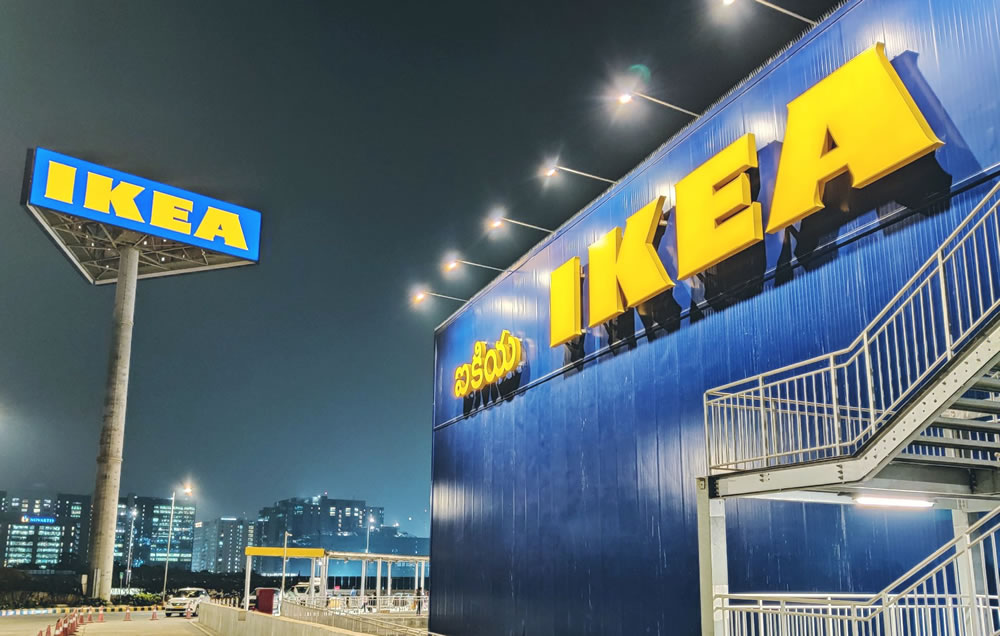Jay Patel
With an area equivalent to 10 football fields, the new store houses a 1,000-seater restaurant as well as a children’s section that is the largest in any IKEA store worldwide, when the world’s largest furniture retailer, IKEA, decided to enter the second most populous country in the world, it wasn’t mere news. Founded in Almhulty (Sweden) and headquartered in Leiden (Netherlands), IKEA had taken 12 years to enter India with quite a few firsts (departure from its global practices) for its ‘long-term’ play.
IKEA has considered doing business in India for years, having first established a presence in 2007 only to run into a raft of regulations limiting foreign investment in the country’s retail sector.
IKEA India has been present in India for 30 years as part of the INGKA Group, sourcing many different products for IKEA stores worldwide. IKEA built a global business empire selling affordable, Scandinavian-design inspired furniture with DIY model. Having honed the IKEA WAY over 51 countries with 403 stores and USD40.2 billion sales, IKEA’s India entry was quite a news globally and in Indian business landscape.
Today, IKEA sources products for approximately € 315 million every year, with the aim of doubling it in the next few years to meet our global and Indian needs. They already work with 48 suppliers in India, engaging 45,000+ direct co-workers and approximately 400,000 coworkers in our extended supply chain. IKEA’s USD1.9 billion investment had been India’s biggest single-brand FDI.
IKEA’s first Indian store was launched in Hyderabad on August 9th 2018 after postponing the inauguration once (slated for July 19th 2018). The 4-storied store in HITEC city (2 floors for parking) was built in 400,000-square-foot (37161.26 square metres) with 7,500 well-researched products (1,000 products selling below INR200) had been quite a business disrupting force for Indian retailing industry in general, and for Indian furniture retailing industry in particular.
India-specific Changes in Brand and Operations: For the first time ever, IKEA was experimenting with an Omni-channel retailing strategy starting from Mumbai in 2019. IKEA’s Hyderabad store has IKEA’s biggest restaurant with 1000-seater with customized Nordic – Indian menu.
The economics of cheap labor are reinforced by the status requirements of high power distance in India–assembling furniture is an activity appropriate for a certain class of people. Home Depot also discovered to its disappointment that in China many people are not in sync with the egalitarian DIY spirit common in the US. So, for IKEA India DIY seemed to be replaced with LUHY (Let Us Help You) with home-delivery (using e-Vehicles). IKEA India has decided to provide assembling services by tie-up with Urban Clap.
IKEA, like many big Western retailers, is betting that India’s mushrooming middle class and young population will spur demand for the company’s products. Roughly half of India’s 1.3 billion people are under the age of 25. While only a small minority can afford an IKEA bed or table set today, incomes and aspirations are rising. The country’s home-furnishings market expanded more than 90% over the past six years to $34.45 billion as of March, Indian retail consultancy Technopak estimated.
The Swedish retailer spent years studying India to understand what makes its residents tick. It set up a makeshift IKEA store near New Delhi and watched how invited families interacted with its products. Its employees have been on more than 1,000 home visits to figure out how Indians eat, sleep, relax and entertain. In preparation for its Hyderabad opening, IKEA flew 75 Indian employees to Sheffield last year to help open a store in the English city. It also opened a pop-up shop in a Hyderabad mall to start introducing its products to potential customers.
The new IKEA will have hundreds of items the average Indian can afford, including a $2.16 jewelry box, shoehorns for 70 cents each and doormats that say “welcome” in different Indian languages for about $5. Roughly 800 of the 7,500 products on sale in the Indian outlet will cost less than $3. It also will offer a sewing service so customers can buy fabric to have curtains made in the store.
India’s Furniture Industry:
The market is expected to expand at a CAGR of 12.91% during the forecast period of 2016-2023. India furniture market growth is driven by various attributes such as rising trend for modular and state of the art furniture among the population living in urban cities, growing urbanization in Indian states, rising demand for durable and hybrid seating furniture. Moreover, the rising growth of wood industry in India further compensates the price of furniture. On the back of these factors the furniture industry is expected to propel in India. Further, the rising trend of online and mobile shopping in India is envisioned to bolster the demand for furniture through online channels.
Various furniture companies such as Pepper fry, urban ladder and others are creating huge demand from these online channels. Apart from this, the demand for low cost plastic furniture is also increasing in the commercial sector. The ease of business doing policies in India gives rise to new businesses across the country. In addition, these increasing numbers of small and medium businesses further boost the demand for low cost plastic furniture products. This factor is believed to foster the growth of the India furniture market over the forecast period.
While IKEA is welcome and hopefully they may bring some innovation, most of their stuff is made of wood which while cheap, nowhere matches the type of wood, the local carpenters use. We are not sure how they plan to compete on that.
There’s also the possibility that other international players like H&M will soon give stiff competition to IKEA by launching their own home furnishings and furniture offerings in India. Not to mention, the challenge posed by the unorganized sector in the home furniture and furnishings space in India.
photo credit: IkeasStoreinHYD.jpg

